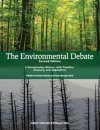"Picking up from the original volume published by Greenwood in 1999, this second edition has 23 additional primary documents in a section spanning 2000–10, covering, e.g., LEED Certification, Oakland's Zero Waste Resolution, Mark Bittman on the American diet, and President Obama on ocean stewardship policy. Focusing yet again on the United States, the volume features a larger and more attractive format with a document selection that remains eclectic: public documents, court cases, opinion pieces, and literary pieces are included in an attempt to cover this broad subject in an engrossing and comprehensive way. Controversy is minimal; little attention is given to opposing views. Each of the eight chronological sections – from creation in Genesis through the present, emphasizing the 20th century – is preceded by an editor's essay that sets the framework for the time period. Each document is then preceded by paragraphs that give minimal biographical and historical information. The excerpts are highly abridged: Rachel Carson's "Silent Spring", for instance, has 400 words. The abbreviated format of the 168 documents is unique and makes the volume useful as a supplement for classwork but not in the same category with The Wilderness Debate Rages On (Univ. of Georgia, 2008), American Earth (Library of America, 2008), or American Environmental History (Columbia Univ., 2007). Mott is a prep school professor and head of the New York City Audubon Society; Neimark is an independent researcher. BOTTOM LINE High school and college students studying public policy sciences, environmental history, and the sciences will find these documents useful as background to their course of study."
- Janice Dunham, Library Journal (05/15/2011)
"Scientific information often generates controversial social issues that polarize personal and religious views about the natural world. The environmental sciences are not free from this effect, considering the contemporary concerns about global climate change, environmental justice, and natural resource conservation. This book is a comprehensive annotated time line of the global events that led to American environmentalism; this new edition (1st ed., CH, Jun'00, 37-5633) covers events to 2010. It is divided into eight sections. Each section represents a historical period that gave rise to a particular paradigm of conflict between environmental awareness and ideology. This historical coverage begins with biblical views of nature. However, the book emphasizes environmental ideological principles following the colonization of America after 1492. A focal point of each chapter is a key document or written account that was central to the environmental ideology of the era. An analysis of the actors contributing to conflicting philosophies is covered within the scope of each chapter. Chapters provide ample original citations as well as other references for further reading. The appendixes include a time line list of the events and a glossary of terms covered in the text. Overall, the book is accurate and well written. Summing Up: Recommended. All levels of academic, professional, and general readers."
– B. R. Shmaefsky, Lone Star College, Choice (06/01/2011)
"Helpfully annotated primary-source documents in chapters from "Foundations of American Environmental Thought and Action" to "Challenges for the Twenty-First Century" are the mainstay of this update and expansion of the 1999 edition. Entries include excerpts from "Christopher Columbus Inventories the New World's Natural Resources (1493)," "Rebecca Harding Davis on Smoke and Soot in a Mill Town (1861)," "John Steinbeck's "The Grapes of Wrath" (1939)," and "Al Gore on the Politicization of Global Warming (2006)." The latter is among 20 documents in a new final chapter covering from 2000 to 2010. Some of the entries are not just one document. For example, "The Founding Fathers on the Care of the Land (1793, 1818)" features quotes from four sources. The work also includes a lengthy introduction, significant back matter, and a very few black-and-white graphics, but the well-chosen primary-source documents that appear in a large font and are set in plenty of white space provide this work's utility."
- Henrietta Thornton-Verma, School Library Journal (06/01/2011)













![Costa Rica Wildlife Guide: Mammals, Birds, Reptiles, Amphibians, Butterflies [English / Spanish]](http://mediacdn.nhbs.com/jackets/jackets_resizer_medium/19/196493.jpg?height=150&width=65)










